If asked to name a plant that symbolises Christmas, most people would probably think of holly, ivy, mistletoe, or the traditional decorated pine tree. But spare a thought for us Aussies – none of these plants are native to our shores (the traditional Christmas mistletoe is a European species). In fact, some of them, like holly, are actually weeds here.
Historical records tell us that the early settlers loved to decorate their new houses at Christmas with Aussie flowers and foliage. But a short foray into the shops today reveals that our modern Australian Christmas motifs have returned to the European natural history of deer, rabbits, holly and northern hemisphere pines.
But Australia has plenty of genuine Christmas flora that we can substitute for the traditional botany…there are no rules!
This year, instead of the traditional Christmas tree, we’ve decorated one of our native ‘pine trees’, a white cypress (Callitris glaucophylla) seedling. Australia has an impressive list of native conifers, as well as plenty of other native shrubs that look great in a pot dressed up in tinsel. Native mistletoe abound, so there’s still an opportunity for Aussie Christmas kisses. We also have a bona fide native holly (Ilex arnhemensis), a Holly Fuschia, a Holly Grevillea, and a Holly-leaved Banksia. And what better substitute for the ivy than our beautiful Hardenbergia violaceae?
Christmas is a few days after the summer solstice in Australia, so we miss out on the snowflakes and fireplaces. But, to make up for it, we get to share the joy of Christmas with a diverse array of flowers and pollinators…
Christmas bells, Blandfordia species
Early European settlers were fascinated with these stunning red and gold bell-shaped flowers nodding among tall grass-like leaves…and rightly so. The Blandfordia genus is in the lily family and consists of only 4 species, all of which are native to eastern Australia – one species grows in Tasmania, the other three are found along the coast from southern Queensland to southern New South Wales (B. grandiflora is endangered in Queensland).
Christmas bells are pollen-limited, meaning that cross-pollination via animals is the plant’s best reproduction strategy. But it seems that quality, not quantity, of pollen is more important. Which is good news, because the main pollinators are nectarivorous birds that only visit every so often; as shown by this memorable 1988 study that used a stuffed honeyeater to show that maximal seed set was achieved after just one probe of the beak.
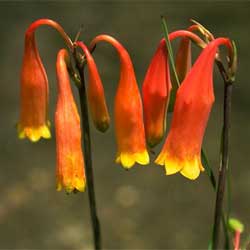
Christmas bush (South Australia), Bursaria spinosa
This hardy shrub in the Pittosporaceae family is party-time for insects. It is found in all states except Western Australia, but the ‘Christmas bush’ common name is only used in some states (it has a variety of other common names too). In Tasmania, over 40 species of bee, wasp, fly, beetle and butterfly have been recorded visiting B. spinosa flowers, while over 25 insect species were found nectaring on the same plant in north-east New South Wales. The plant is also the larval food plant for a couple of threatened butterflies, the Bathurst Copper and the Eltham Copper.
This Christmas bush is a great example of how unique Australian flora is. The infamous ‘pollination syndromes’ hypothesis was proposed as a way to predict the pollinators of a flower based on its floral traits. While this approach can be useful, its accuracy has since been proven questionable. Many flowers can have a combination of traits that ‘predict’ more than one type of pollinator, and Christmas Bursaria is a classic example. The reality is that most pollinating insects aren’t that fussy – as long as flowers are around, it’s Christmas every day for them!
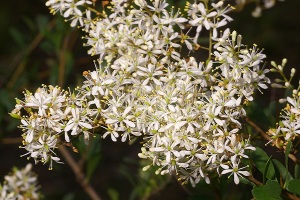
Christmas Tree (Western Australia), Nuytsia floribunda
This fascinating tree can grow up to 10 m in height, and is the world’s largest mistletoe. It is one of only three terrestrial species in the hemiparasitic Loranthaceae family, most of which we are used to seeing aboveground, attached to their host’s branches. The West Australian Christmas tree is a root parasite, and has unique scissor-like root tips that snip its host’s roots to get a share of the nutrients.
But what of its pollinators? Very little research has been done on N. floribunda’s pollination ecology, but it is assumed to be bird-pollinated, like most other mistletoes – naturalist Oswald Sargent noted in 1918 that the flower structure suggested a ‘vigorous’ pollinator. But these Christmas flowers are still popular with insects. Observations from Western Australia recorded over 20 species of wasp, fly and beetle on the flowers, particularly jewel beetles (Buprestidae) and flower wasps (Scoliidae, Tiphiidae). Nuytsia is andromonoecious, meaning each of its orange inflorescences holds both male/female flowers and male-only flowers. From a pollination perspective the role of this flowering strategy is not well-understood, but it could be to attract more pollinators, or to enhance the plant’s male fitness.
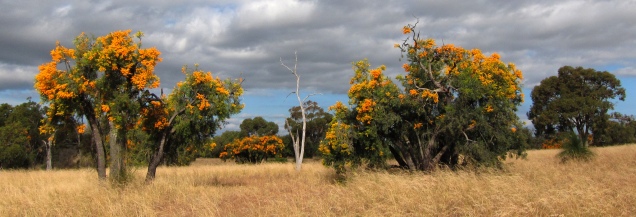
Red Flowering Gum, Corymbia ficifolia
If you want insects and birds in your garden, plant a Red Flowering Gum. Most people are familiar with its various cultivars as common urban ornamentals across Australia, with their huge, starburst blossoms ranging from pinky-white to deep red. The original C. ficifolia is native to the Albany region and conveniently bursts into stunning red blossoms around Christmas time.
If you stop to take a look at a branch, it is guaranteed to be teeming with bees, beetles, ants, butterflies, flies and wasps, having a Christmas feast on the nectar-rich blossoms. Honeyeaters are regular visitors too, especially in the morning and evening.
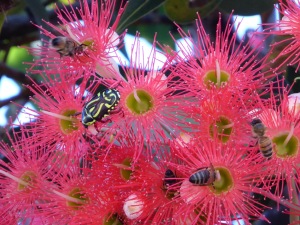
Christmas Orchid, Calanthe australasica
This is the only endemic Australian species of the widespread Calanthe genus – it has only recently been separated from C. triplicata, which is found across Africa, Asia and Oceania from Madagascar to the Pacific Islands. It grows on rainforest floors, sometimes in wet sclerophyll forests, from southern New South Wales to northern Queensland.
There is not much information available on Christmas orchid pollinators in Australia. Two other Asian Calanthe species are pollinated by bees (C. striata and C. discolor). But the closely-related C. triplicata, which our Aussie species was once thought to be, is likely pollinated by butterflies or hawkmoths in its Asian range. Given that our native Christmas orchid grows naturally on dim-lit rainforest floors, where sun-loving bees would be hard to find, it is possible that it is also moth-pollinated.
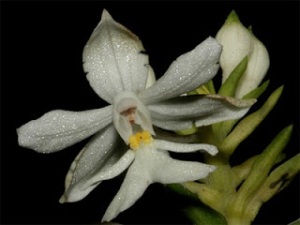
There are plenty of other Australian plants that keep our wild pollinators happy through summer. Wouldn’t it be great to see more Christmas cards, decorations and trimmings inspired by Aussie botanical motifs?
© Manu Saunders 2015
We do have so many stunning native flowering species, don’t we? I usually try to send Christmas cards to overseas friends and relatives that show our native flora and fauna and they often comment on our decorative and unusual blossoms. The honeyeaters are out in force in my garden at present, attracted by the blooms of natives. Another excellent post as always, Manu. Have a wonderful Christmas! 🙂
LikeLiked by 1 person
Thanks Jane! Merry Christmas to you too, hope you have a happy & safe summer! 🙂
LikeLike
Great blog. I never knew Bursaria spinosa was called Christmas Bush here in Tasmania! I call it Native Box or Sweet Bursaria or it gets an expletive when I prick myself 🙂 Christmas Bush I had always linked to Prostanthera lasianthos – it produces a wonderful flower and the mint smell is amazing. Early Tasmanian settlers used Exocarpos cupressiformis (Native cherry) as a Christmas tree. Today my 8 yr old asked what the red berries were on the ground – and above us was a Native cherry. It’s red berries do look like tiny baubles. The early settlers would cut the branches and use them as Christmas trees. Suffice to say many Native Cherry trees were reduced in the forests and woodlands surrounding Hobart because of Christmas, and also as it is toxic to stock. One tree that is doesn’t have a Christmas label but is a stunning Christmas tree is Callitris oblonga. It is so soft! Have a merry Christmas. 🙂
LikeLiked by 1 person
Thanks Perpetua. There are a few ‘christmas bushes’, and I think each state has their own, which is probably called other things elsewhere! The joys of common names…
I didn’t know that native cherry was an early christmas tree, but it sounds perfect! Merry Christmas to you too 🙂
LikeLiked by 2 people
Our mistletoes are pretty fantastic. Here’s one (Lysiana exocarpi, aka Harlequin Mistletoe) growing on a Bursaria spinosa. aka Christmas Bush as you put it, more commonly called Sweet/Prickly Bursaria around here, i’ve also heard it called Prickly Box in Tasmania.
Pics: https://twitter.com/bencourtice/status/682154049089613824
LikeLiked by 1 person
Thanks Ben, our Aussie mistletoes are gorgeous! Bursaria has lots of common names, some appear to be more regional than others.
LikeLiked by 1 person
And Alchornea ilicifolia could pass as a substitute if holly is an essential. I believe the classification has changed since I learned of this Queensland native. http://keys.trin.org.au/key-server/data/0e0f0504-0103-430d-8004-060d07080d04/media/Html/taxon/Alchornea_ilicifolia.htm
LikeLiked by 1 person
Thanks David, I missed that one. It definitely would make a great holly substitute!
LikeLike
I believe the classification has changed since I learned of this Queensland native. The early settlers would cut the branches and use them as Christmas trees. Suffice to say many Native Cherry trees were reduced in the forests and woodlands surrounding Hobart because of Christmas. The honeyeaters are out in force in my garden at present, attracted by the blooms of natives.
LikeLike
This is so beautiful! Traditional decorations are my favorite. I’m gonna come back to this at Christmas and use it as inspiration. The spinning baubles are genius!
LikeLike